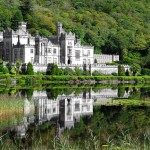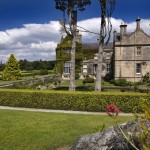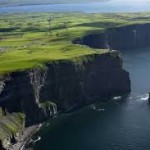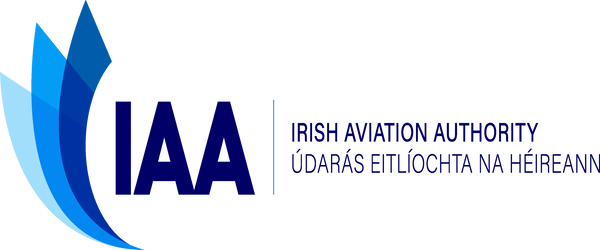Start your Irish Holiday here!
The Wild Atlantic Way driving tour is based on the most captivating ,longest defined coastal route in the world and stretches for 2500km along Ireland’s western seaboard. The West of Ireland and beautiful scenery go hand in hand. From Kinsale to Galway you’ll find towering mountain ranges, vast beaches of golden sands and sheer cliff face. This self drive tour will allow you to track the rugged coastline of the West of Ireland where you will experience the Irish culture and traditions .This tour will take you off the beaten track and allow you discover for yourself the true beauty of Ireland’s west coast. Explore and experience a whole new world as you journey through the west of Ireland and enjoy part of the Wild Atlantic Way – Ireland’s 2,500km coastal driving route!
Out at the very edge of Europe, this breath- taking route encompasses stunning headlands,beautiful beaches, jagged cliffs and also some of Irelands most famous driving routes such as the Dingle Peninsula and the Ring of Kerry.
This tour is perfect if you want to take things at your own pace, see all of southern Ireland’s most loved attractions and maybe even find a piece of hidden Ireland for yourself.
Overnight Locations :
Kinsale for 2 nights
Kenmare for 1 night
Dingle for 2 nights
West Clare for 1 night
Connemara for 1 night
Westport, Mayo for 2 nights
Galway for 1 night

| Low Season | B&Bs | 3 * Hotel | 4* Hotel |
| Bed & Breakfast for 10 nights and Rental of an Economy Manual car | €606 pps | €885 pps | €1,047 pps |
| High Season | B&BS | 3* Hotel | 4*Hotel |
| Bed & Breakfast for 10 nights and Rental of an Economy Manual car | €809 pps | €1,122 pps | €1,366 pps |
*pps=per person sharing
Tour package Includes :
- Economy Manual vehicle eg., Ford Fiesta with unlimited mileage based on a minimum of 2 people travelling together. Inclusive of: Collision Damage Waiver (CDW), theft protection (TP), government tax (VAT) and Location Service Charge (upgrade rates for larger or automatic transmissions are available on request).
- Full breakfast daily except on day one
- All local taxes and hotel service charges
- Confirmation documents for each of your accommodations including driving directions
- All rates above are per adult sharing, child and single supplements apply
- Low Season- November-March
- High Season- April-October
Day 1- Shannon to Kinsale
Your Irish Holiday begins here. Travel to Kinsale via Limerick City, Blarney and Cork City with optional detours to the Tipperary towns of Cahir & Cashel and Cobh in Cork. Among the most interesting attractions in Limerick are King John’s Castle and The Hunt Museum. From there, the direct route to the small coastal town of Kinsale will allow you to ‘Kiss the Blarney Stone’ at Blarney Castle and visit the Cobh Heritage centre near Cork. Cobh, situated on one of the world’s largest natural harbours, was the last port of call for the ill-fated Titanic in 1912 and was the closest port to the site of the sinking of the Lusitania in 1915. The Heritage centre also recounts the story of those Irish who left Ireland during ‘The Famine’. An optional detour includes visits to ‘The Rock of Cashel’ and ‘Cahir Castle’, both in Tipperary and both are amongst Ireland’s premiere historic attractions. Kinsale is a delightful harbour town that has retained its old world charm and has a myriad of old Irish pubs and excellent restaurants as well history laden attractions such as the Desmond Castle Museum and the star shaped ‘Charles Fort’ from the 17th century.
Day 3- Kinsale to Kenmare
Today you have the option of the scenic but longer coastal route or the shorter route via Blarney Castle. The longer route includes visits to Mizen Head, the southernmost point in Ireland, as well as Bantry House and Gardens and the French Armada Centre, also in Bantry. From Bantry, you will be heading north to Killarney via the Healy Pass. Have your camera’s at the ready for some breathtaking scenery across the Caha Mountains that divide Cork from Kerry. After the mountain pass, you come to the town of Kenmare. The town was founded in 1670 by Sir William Petty and has a history of lace making, demonstrations of which can be seen at the town’s Heritage Centre
Day 4- Kenmare to Dingle
We travel to the fishing town of Dingle today as well as the dramatic Dingle Peninsula. The Dingle Peninsula has more interesting antiquities, historic sites and varied mountain scenery than any other part of Ireland. Dingle is the most westerly town in Europe and attracts large numbers of visitors each year, many of whom come to learn the Irish language in the surrounding ‘A Flor-Gaeltacht’ – Irish speaking district. On route stop in the village of Annascaul, the birth place of Jerome Connor, the famous sculptor, and Tom Crean, a local hero who accompanied Scott and Shackleton on three Antarctic expeditions, including Scott’s doomed attempt to reach the South Pole. On his return to Annascaul Crean opened the “South Pole Inn”, which is still in business today. Minard Castle is also well worth a visit. The castle is said to have been built by the Knight of Kerry and is the largest fortress on the peninsula. Continue on past Dingle and visit Dunbeag Promontory Fort. What makes it one of the most dramatic archaeological sites on the peninsula is that results show that it was begun in the late Bronze Age, 800 BC. Continue on to Slea Head and here you will see Dun An Oir (Fort of Gold. Here in 1580, after three days siege, over 600 Irish and Spanish soldiers surrendered to Lord Grey only to be massacred by his troops. Nearby is the Gallarus Oratory, one of the best preserved early Christian church buildings in Ireland. Back to Dingle for the evening. Here you will find among other great pubs and restaurants, Dick Macks, possibly Dingle’s most famous pub, which is half a leather shop and half a pub so you can buy a pint and a purse at the same time! Foxy John’s is a hardware store and pub combined – an unusual arrangement to say the least. This is a great highlight for many on their great Irish Holiday!
Day 6- Dingle to Clare
After an early breakfast depart Dingle in the direction of Brandon to drive over the renowned Conor Pass, Ireland’s highest mountain pass. At the summit Brandon and Tralee Bays can be seen to the north, with the sandy Castlegregory peninsula separating them and to the south lies Dingle Bay. Continue to Tralee and Tarbert where you will take a ferry crossing on the Shannon Estuary to County Clare. Continue north to the Cliffs of Moher. The majestic Cliffs of Moher are without doubt one of Ireland’s most spectacular sights and overlook the Atlantic Ocean on the coast of West Clare. You then arrive at the village of Doolin. Doolin is world-famous for its wealth of Irish folk music and in recent years has been attracting crowds to spontaneous sessions in any one of its excellent pubs. Just north of the Cliffs you then have the lunar like Burren region and the ancient Poulnabrone Dolmen Tombs as well as the Aillwee Caves.
Day 7- Doolin to Connemara
From there travel west of Galway to the hauntingly beautiful Connemara Region. Situated on the most western seaboard of Europe, this unspoilt region boasts breathtaking scenery. The characteristic features of Connemara include its rugged, unpolluted coastline, dramatic mountains, numerous lakes and rivers and woodlands and the renowned Connemara National Park. Visit Kylemore Abbey and the Lough Inagh Valley as well as the spectacular Sky Road near the town of Clifden. You can also visit the fishing village of Roundstone and see how a ‘Bodhran’ (traditional Irish Drum) is made. Alternatively, you may prefer to take the ferry to the Aran Islands. Aran will take you back to an Ireland of Celts and Early Christians. Take a pony and trap, or a guided tour from the pier up the island to the stone fort of Dun Aengus. Dún Aengus fort is located on top of a 300ft high sea cliff and is one of the finest prehistoric monuments in Western Europe.
Day 8- Connemara to Westport
Touring north from Connemara, you will also be able to walk along the fjord at Killary harbour or indeed take the catamaran cruise through Ireland’s only fjord. From there travel just south of Westport to see Croagh Patrick, otherwise known as Ireland’s ‘Holy Mountain’ upon which St. Patrick (according to Irish folklore) spent 40 days fasting. The area around Croagh Patrick is rich in archaeological remains which provide an interesting insight into life in times past. Findings date back to 200 B.C. Just north of the town of Westport in the county of Mayo is Ireland’s least populated region where you can walk the open countryside for miles with no company other than the local sheep. The amazing geology, archaeology, botany and wildlife of this region of North Mayo is interpreted for us at The Céide Fields Visitors’ Centre with the aid of an audio-visual presentation and exhibitions. You may also wish to visit Westport House – Designed by the famous architects Richard Cassels and James Wyatt in the 18th century, Westport House is located west of the Shannon and is one of Irelands’ most historic homes open to the public.
Day 10- Westport to Galway
Heading south from Westport, you reach Galway, the ‘City of the Tribes’ also known as Ireland’s Cultural and festival capital. With its street entertainers and traditional pubs with great music, Galway and in particular, the Quays area of the city centre will enthrall you particularly in the evening time. Other sites in Galway include Ireland’s largest medieval parish church, the Collegiate Church of St Nicholas of Myra dating back to 1320. Christopher Columbus reputedly worshipped in this church in 1477. Also nearby are Galway Cathedral, the Spanish Arch and Eyre Square
Kylemore Abbey 
Kylemore Abbey is the ideal destination for a day out in majestic Connemara at any time of year. Located about an hour’s drive from Galway City, a visit to Kylemore will rank as an unforgettable memory. The dramatic landscape and iconic image of a gothic castle reflected in a Connemara lake has made Kylemore Abbey world-famous and it is now the largest tourist attraction in the west of Ireland. The Benedictine nuns invite visitors to experience the Victorian atmosphere of the Abbey’s restored rooms, miniature gothic church, head gardener’s house and garden boy’s house. Learn of the tales of tragedy and romance, the engineering initiatives, model farms, royal visits and the Abbey’s former role as a girls boarding school. Kylemore’s many nature trails, woodland walks and the magical award-winning walled garden offer a wonderland to explore. Discover the Victorian heritage of the walled garden, where only flower and vegetable varieties from that era are grown. ) Enjoy refreshing walks and scenic views as every season has something different to offer at Kylemore. Mitchell’s café and the tea house offers home-cooked food made from recipes perfected by the Benedictine nuns and using fresh vegetables and herbs from the walled garden. The craft shop has a wide selection of design-focused Irish giftware including artisan food products, knitwear, pottery, art and handcrafts made by the Benedictine nuns at Kylemore. Choirs travel from around the world to Kylemore Abbey to sing in the Gothic church with its superb acoustics. All are welcome to attend the choral performances and admittance is included in the Kylemore entry fee.
Muckross House & Gardens 
This magnificent Victorian mansion – one of Ireland’s leading stately homes – is situated amidst the spectacular scenery of Killarney National Park in County Kerry. The elegantly furnished rooms portray the lifestyles of the landed gentry, while downstairs in the basement you can experience the working conditions of the servants employed in the House back in the day.
Muckross House is also home to a number of skilled craftworkers, who can be seen using skills in the crafts of weaving, pottery and bookbinding. Many exotic trees and shrubs flourish in the mild climate and sheltered location of the Muckross gardens. Attractive features include a fine collection of rhododendrons and azaleas, an outstanding rock garden on a natural rock outcrop and beautiful tree-fringed lawns.
Cliffs of Moher 
The Cliffs of Moher, one of Ireland’s top visitor attractions, loom high over County Clare’s west coast. Standing 214 metres at their highest point, the cliffs stretch for 8km along the Atlantic coastline. From the cliffs, one can see the Aran Islands, Galway Bay, The Twelve Bens, the Maam Turk Mountains in Connemara and Loop Head to the south. O’Brien’s Tower, another of Ireland’s most photographed landmarks, guards one prominent headland of these majestic cliffs. The Burren and Cliffs of Moher region of north Clare has been awarded the prestigious designation of membership of the UNESCO supported Global Geopark network at the 10th European Geoparks Conference in Langesund, Norway. This iconic location attracts close to one million visitors per year.
The unusual, underground visitor centre also houses the exciting Atlantic Edge display.
This huge, domed cave contains images, exhibits and displays. The centre also has a gift shop stocking official Cliffs of Moher products, maps, guides, books and DVDs, visitor information and an accommodation booking service. Other facilities of this fully wheelchair accessible premises include a baggage store and ATM. Friendly staff will answer questions, provide assistance, give information on and directions to other attractions in the area.
Not sure if a trip to Ireland is for you? Why not check out Limerick Travel or Let’s Go Travel for other ideas!
